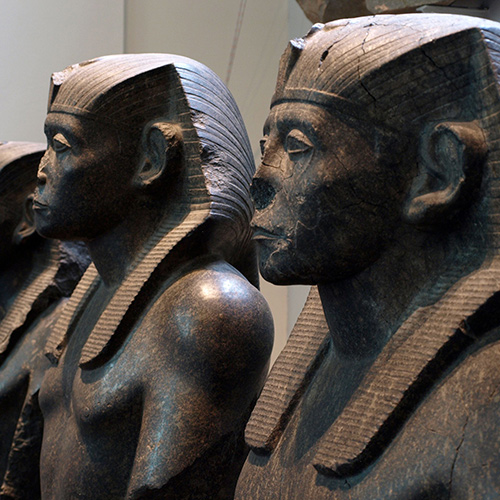
Black granite statues of the pharaoh Senwosret III, 12th dynasty, circa 1850 B.C.E.
Egypt, one of the great superpowers of the ancient world, produced a culture and system of government that endured for more than 3,000 years. The funerary monuments and statuary erected for the ancient Egyptian royal family reveal that the nation’s people believed in the reciprocal nature of the divine rule. Ideally, the king or queen ensured economic prosperity and defended against all threats. In return, the subjects were devoted to the royal family, comforted by the belief that divine wisdom and justice inspired their ruler. However, was that assumption a valid one?
Egyptologist Jacquelyn Williamson draws from the most recent archaeological evidence to examine four of Egypt’s most influential rulers and the impact of their reigns.
10–11 a.m. Khufu: Builder of the Great Pyramid
The Great Pyramid reveals as much about the life and times of the people who built it as it does about Khufu, the great king it memorializes. In inscriptions, devoted workers brag about their right to work on the pyramid, and archaeological evidence (including an industrial-size kitchen) indicates they were well-fed and well-housed at the king’s expense—and looked forward to a well-supported eternal life by being buried close to the pyramid.
11:15 a.m.–12:15 p.m. Senwosret III: The Sad King
Senwosret III came to the throne as Egypt faced climate change, widespread starvation, and political strife leading to a long civil war. His royal portrait reflects the deep lines and baggy, sleep-deprived eyes of a leader burdened by worry for his people. Williamson uses Senwosret’s pyramid complex and the poetry of the period to examine the country’s economic and social troubles.
12:15–12:45 p.m. Break
12:45–1:45 p.m. Tutankhamun: The Dark Side of Empire
Tutankhamun is the best-known king of ancient Egypt, but we know less about his dark family history and phenomenal inherited wealth. Williamson explores the source of that fortune—international conquest—and discusses the latest excavations of the palace of his grandfather, Amenhotep II. His father, Akhenaten, raised a royal city built by adolescents who were worked to death and buried in mass graves.
2–3 p.m. Cleopatra: A Victim of Ancient Fake News?
The historical depiction of Cleopatra as a wily seductress who entrapped Marc Antony has recently come to be seen as Roman propaganda. The PR offensive was spearheaded by Octavian, the future Augustus Caesar, under the guise of protecting Rome from moral decay and promising a return to proper “family values”—and to remove threats to his own political power. Williamson contrasts the known facts of Cleopatra’s life with the portrait promulgated by Rome.
Williamson is associate professor of art and archaeology of the ancient Mediterranean world and director of the ancient history and Mediterranean archaeology minor at George Mason University.
General Information